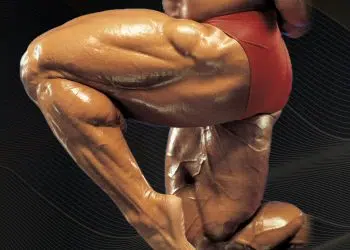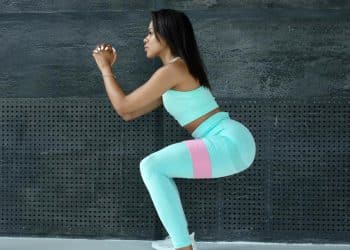The deadlift is probably the most satisfying exercise you can do in the gym. Sure, the bench press is cool but gripping and ripping a heavy barbell off the floor makes you feel like a total badass!
No barbell exercise allows you to lift as much weight, and seeing the bar flex and bend as you lift is always a thrill.
However, while the deadlift is a tremendous exercise, not everyone is built to do it well. For example, tall lifters often struggle to reach the bar without rounding their lower backs. Tight hamstrings can also lead to a rounded back.
A rounded lower back is a weak lower back, which is why the deadlift from the floor is risky for some people.
That said, being tall or having a lack of mobility doesn’t have to prevent you from doing deadlift-type movements. Rack pulls compare favorably to deadlifts and features an elevated starting position that saves you from leaning so far forward. Rack pulls are far more spine-friendly alternatives to conventional deadlifts.
Rack pulls are an excellent deadlift variation, but they aren’t always practical. After all, you need a power rack with which to do them. The good news is that there are several equally effective exercises you can do instead.
Level Up Your Fitness: Join our 💪 strong community in Fitness Volt Newsletter. Get daily inspiration, expert-backed workouts, nutrition tips, the latest in strength sports, and the support you need to reach your goals. Subscribe for free!
In this article, we reveal the seven best rack pull alternatives for building a stronger, more muscular posterior chain.
Rack Pull Anatomy Basics
The rack pull is a compound exercise that involves multiple joints and muscles working together. Any movement that’s an alternative to rack pulls should work most of the same muscles.
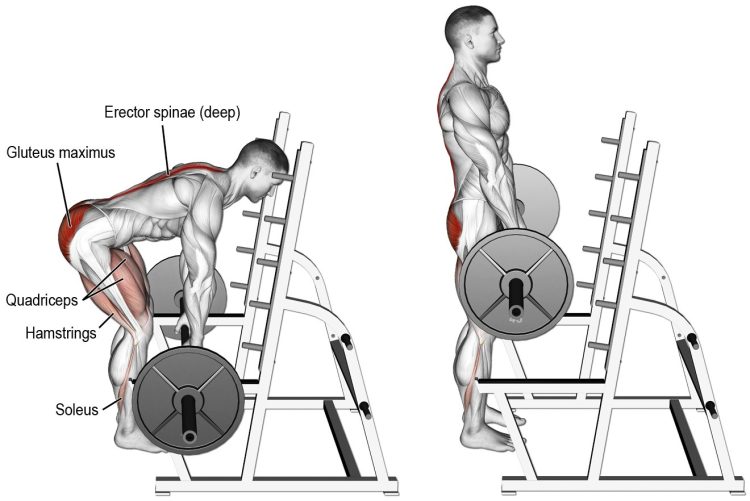
The main muscles trained during rack pulls are:
- Gastrocnemius and soleus – calf muscles
- Hamstrings – rear of the thigh
- Quadriceps – front of the thigh
- Gluteus maximus – bottom/butt muscles
- Erector spine – muscles on either side of your spine
- Core muscles – deep muscles surrounding your internal organs
- Rhomboids and trapezius – muscles of the upper back
- Latissimus dorsi – side upper back muscles
- Deltoids – muscles of the shoulder
- Biceps and triceps – front and back of the upper arm
- Forearm flexors – gripping muscles
Rack Pull Alternatives
As you’ve seen, the rack pull is virtually a full-body exercise. However, they emphasize the muscles on the back of the body, which are collectively called the posterior chain.
The following rack pull alternatives are also effective posterior chain developers.
1. Romanian Deadlift
No rack for rack pulls? Not a problem! Romanian deadlifts involve a similar movement and range of motion. Instead of lowering your barbell to a rack, you stop each rep at the end of your natural range of motion. Romanian deadlifts are a very effective posterior chain exercise. However, you probably won’t be able to go as heavy as rack pulls.
How to do it:
- Hold your barbell with a shoulder-width, overhand or mixed grip.
- Stand with your feet about hip-width apart. Pull your shoulders down and back, brace your core, and bend your knees slightly.
- Without bending your legs any further, push your butt backward and lean forward from your hips, taking care not to round your lower back. Lower the bar down the front of your legs.
- Keep your neck aligned with the rest of your spine as you lean over.
- Descend as far as your flexibility allows. The weight should not touch the floor.
- Drive your hips forward again and stand up straight.
- Do not lean back at the top of the movement.
- Repeat for the desired number of repetitions.
Pro tip: If using heavy weights, it may be necessary to use lifting straps so your grip doesn’t fail prematurely. If you use a mixed grip, switch your hands around set by set to avoid unbalanced muscle and strength development.
2. Deadlift from Blocks
One of the downsides of rack pulls is that they can damage your barbell. Resting a heavily loaded barbell in a power rack concentrates all that weight onto two small areas near the ends of the bar, which can cause it to bend and then remain so. Deadlift bars are especially susceptible to being damaged this way, as they’re made to flex in the middle and not at the ends.
However, deadlifting from blocks will not damage your barbell, so they’re a bar-friendly alternative to rack pulls.
How to do it:
- Place your loaded barbell on sturdy blocks. You can raise the bar a few inches, up to knee height, or anywhere in between. The higher the blocks, the shorter your range of motion will be.
- Walk up close to the bar and position your feet about hip width apart, with toes pointed forward or slightly outward.
- Grip the bar with your hands just outside of your legs and keep your body close to the bar. Position your shoulders slightly in front of the bar.
- Flex your lats, pull your chest up, retract your shoulder blades, and tighten your core muscles.
- Drive your feet into the floor, push your hips forward, extend your knees, and stand up. Squeeze the glutes at lockout for stability and to prevent hyperextension of the lower back.
- Hold the weight for a second or two, then lower the bar back to the blocks. Reset your grip and then repeat.
Pro tip: Raise the height of your blocks set by set to allow for increases in fatigue. Each set should feel slightly easier than the last as your range of motion decreases.
3. Deadlift With Chains
While this rack pull alternative does start with the barbell resting on the floor, the weight increases as you near lockout, and there is less load at the start of each rep. This means less stress on your lower back, but you can still work with heavy weights.
How to do it:
To do this exercise, simply attach your chains to the ends of your barbell and then deadlift as normal. Use light to moderate weights and remember the load from the chains/bands will kick in/increase partway through your rep and max out at the top.
Pro tip: Some gyms have chains that you can fix to the end of your barbell, or you can use resistance bands to achieve a similar effect. If your gym doesn’t have chains, buy some bands and keep them in your training bag.
4. Cable Pull Through
Cable pull-throughs are a popular accessory exercise in powerlifting. They work many of the same muscles as rack pulls but are somewhat more lower back friendly. They also tend to keep your muscles under tension for longer. This is an excellent rack pull alternative for anyone who prefers cable exercises to barbell training.
How to do it:
Level Up Your Fitness: Join our 💪 strong community in Fitness Volt Newsletter. Get daily inspiration, expert-backed workouts, nutrition tips, the latest in strength sports, and the support you need to reach your goals. Subscribe for free!
- Attach a rope handle to a low pulley machine. Stand with your back to the weight stack, feet astride the handle.
- With your abs braced and shoulders down and back, bend down and grab the handle with both hands. Stand up and take a couple of steps forward to tension the cable.
- Stand with your feet shoulder-width apart, knees slightly bent, hands in front of your hips. This is your starting position.
- Push your hips back and lean forward until you feel a deep stretch in your hamstrings. Maintain a neutral spine throughout, including your upper back and neck.
- Drive your hips forward and stand back up.
- Hinge forward again and repeat.
Pro tip: Use two rope handles instead of one, take an extra step or two forward at the start of each rep, and then reach back through your legs further to increase the range of motion and the effectiveness of this exercise.
5. Kettlebell Swing
I’ll be the first person to admit that kettlebell swings don’t look much like rack pulls. However, if you take a moment to analyze the movement, you’ll see that these exercises share several similarities and work many of the same muscles. The main difference is your movement speed. Where rack pulls are a slow, grinding movement, swings are faster and more powerful.
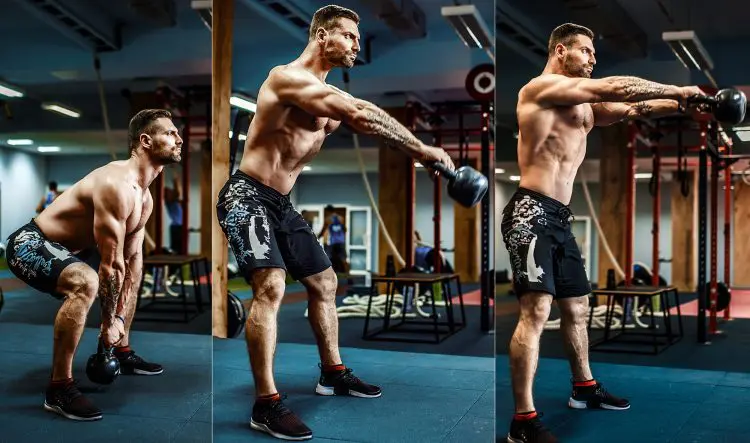
How to do it:
- Hold a kettlebell in front of your thighs and stand with your feet about shoulder-width apart. Bend your knees slightly and brace your core.
- Keeping your arms straight, push your butt back and lean forward from your hips, lowering the weight to about knee height.
- Without rounding your lower back, snap your hips forward. Use this momentum to swing your kettlebell out and up to around eye level. Tense your glutes, lats, and abs at the top of the rep.
- Lower the weight and repeat.
- Set a brisk but even rhythm, and stick to it for your entire set.
- You can also do this exercise using a dumbbell held in a fingers-interlocking grip.
Pro tip: Imagine you are jumping forward at the start of each rep. This will fire up your glutes and hamstrings and make the exercise more powerful.
6. Barbell Hip Thrust
Hip thrust is another exercise that doesn’t look like rack pulls but works many of the same muscles. In this case, your upper and lower back are less involved, and your glutes and hamstrings do most of the work. For a back-friendly rack pull alternative, this effective exercise is tough to beat. It’s also an excellent booty builder!
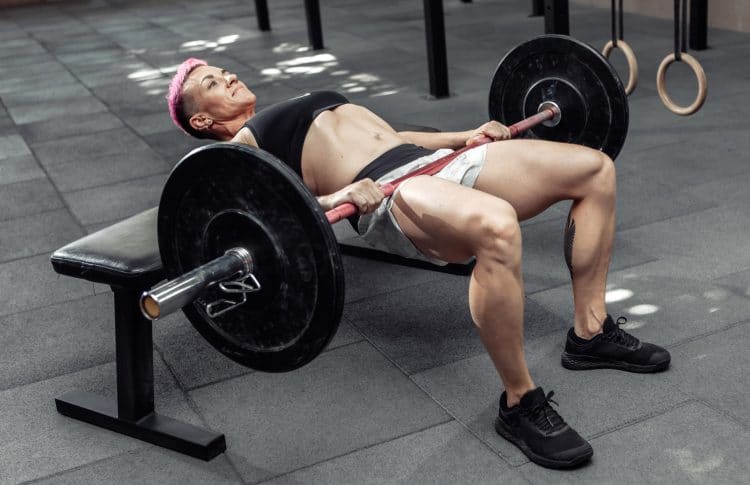
How to do it:
- Sit on the floor with your legs bent, your feet on the floor, and your back against a flat exercise bench. Weigh the bench down to stop it from moving during your workout.
- Drive your feet down into the floor and lift your hips until your thighs and body are roughly parallel to the floor. Contract your glutes and hamstrings as hard as possible for 1-2 seconds.
- Lower your butt back down to the floor and repeat.
Pro tip: Place a folded towel or exercise mat on your hips or use a squat pad to make this exercise more comfortable. Put your feet on a raised surface, e.g., an aerobic step, to increase your range of motion and exercise difficulty.
7. Good Morning
The barbell good morning is a classic strength training exercise. It’s so-called because, when you do it, you look a little like you are bowing to greet someone. The good morning works almost all of the same muscles as rack pulls, but there is less upper back and quads engagement. On the downside, this exercise can be hard on your lower back, so don’t go too heavy too soon, and definitely do NOT round your spine!
How to do it:
- Rest and hold a barbell across your shoulders as though you were going to do squats.
- Stand with your feet between shoulder and hip-width apart.
- Bend your knees slightly and keep them rigid throughout.
- Without rounding your lower back, lean forward as far as your flexibility allows. Grip the bar tightly to stop it from rolling up your neck.
- Stand back up and repeat.
Pro tip: If you find holding the bar across your neck uncomfortable, try resting it in the crooks of your elbows. This is called a Zercher good morning. Some people find this variation more practical.
Rack Pull Alternatives – FAQs
What is the best rack pull alternative?
The best rack pull alternative depends on what you are training for. For example, if you want to build strength, the deadlift from blocks is hard to beat. It’s a great exercise for lifting heavy weights.
But, if you are more interested in hypertrophy, Romanian deadlifts and good mornings are excellent options. If you want to lift and firm your butt and burn some calories and fat, kettlebell swings are a great choice, as are barbell hip thrusts.
Use the exercises that best match your training goals.
How many reps should I do for the rack pull alternatives?
Your rep range depends on your goal and what equipment you have available. For example, if you are training for strength, you should mainly use heavy weights and low reps, i.e., 1-5 reps per set with 85% or more of your 1RM.
If you are training for hypertrophy or muscle growth, higher reps and lighter weights work best, e.g., anywhere from 6-30 reps per set (1).
Of course, suppose you only have access to light weights or are doing bodyweight exercises. In that case, you’ll have to train to failure regardless of how many reps you do. Taking your sets close to failure will increase muscle size and improve your strength, although strength gains will be somewhat less than when lifting heavy weights.
Why does my lower back round during rack pulls, deadlifts, kettlebell swings, etc.?
Lower back rounding is a common problem that can be caused by various issues. Frequent causes of lower back rounding during hip hinge exercises include:
- Tight hamstrings
- Tight hip flexors
- Poor posture due to prolonged sitting
- Poor positional awareness
- Weak glutes
- Weak core
- Weak spinal erectors
The good news is that all these things can be fixed with corrective stretching and strengthening exercises. However, you first need to reduce your weights, use a shorter range of motion, and stop rounding your lower back. If you continue to do it, you could end up with serious lower back pain.
More Alternative Exercises:
- Back Extension Alternatives
- Seated Cable Row Alternative For Building A Massive Back
- Bent Over Row Alternatives for A Bigger, More Muscular Back
- Inverted Row Alternatives for a Broader, More Muscular Back
- Home Squat Alternatives for Strong, Sculpted Legs
- Smith Machine Squat Alternatives for Powerful, Muscular Legs
- The Best Hack Squat Alternative for Bigger, Stronger Legs
- T-Bar Row Alternative For a Massive Back
Wrapping Up
One of the best things about strength training is how many exercises you can do for the same parts of your body. Just because one exercise is off the menu doesn’t mean you can’t train that muscle group with a different movement or piece of equipment.
The rack pull IS a fine exercise, but it’s not the only way to train your glutes, hamstrings, and back. In fact, it’s just one of the many amazing posterior chain exercises available.
So, don’t worry if you can’t do it or don’t like it; there are lots of equally effective exercises you can do instead.
Use any of these rack pull alternatives to develop your posterior chain safely and efficiently.
References:
1- PubMed: Effects of resistance training performed to repetition failure or non-failure on muscular strength and hypertrophy: A systematic review and meta-analysis https://pubmed.ncbi.nlm.nih.gov/33497853/
Interested in measuring your progress? Check out our strength standards for Bench Press, Good Morning, Smith Machine Squat, and more.




